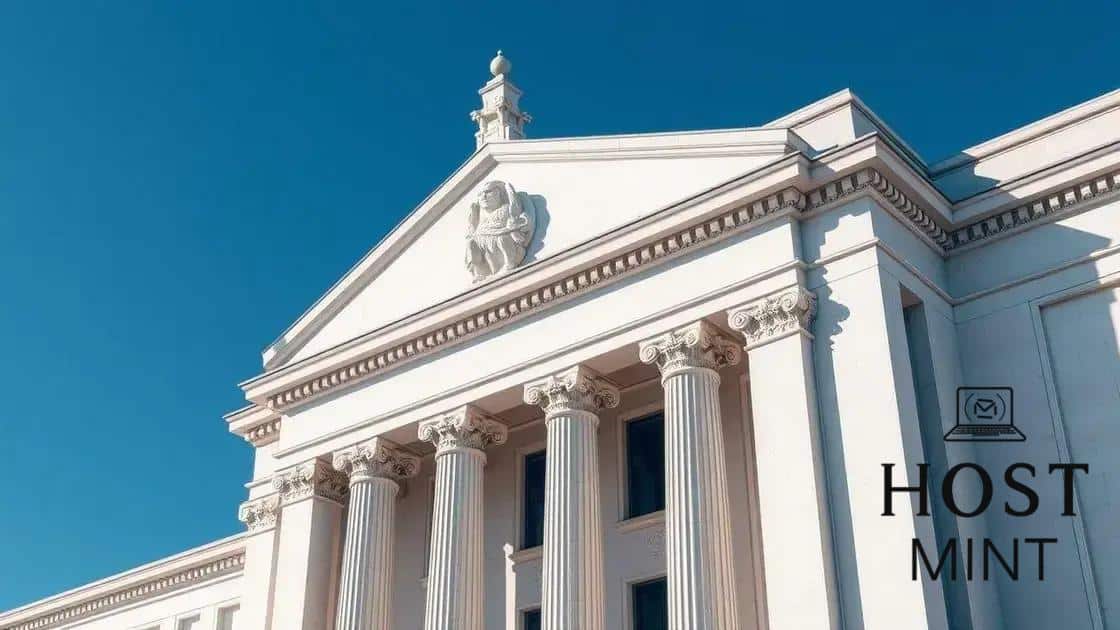Federal Reserve’s potential interest rate adjustments explained

The Federal Reserve’s potential interest rate adjustments significantly impact borrowing costs, consumer spending, and overall economic growth, responding to inflation, employment levels, and global economic conditions.
Federal Reserve’s potential interest rate adjustments can have a profound effect on your finances and the broader economy. Have you ever wondered how these decisions might impact your loan rates or savings? Let’s dive into this crucial topic.
Understanding the Federal Reserve’s role
The Federal Reserve plays a crucial role in stabilizing the U.S. economy. Effectively, it acts as the central bank, managing the nation’s monetary policy. Understanding its functions is essential for grasping how interest rates work and influence economic growth.
Core Functions of the Federal Reserve
One major aspect of the Federal Reserve’s role is to ensure a stable financial system. It does this through several key functions:
- Implementing monetary policy to control inflation
- Supervising and regulating banks to maintain trust
- Providing financial services to government and financial institutions
These functions play a pivotal part in how the Fed influences the economy. For instance, by adjusting interest rates, the Fed can affect borrowing costs and, subsequently, consumer spending.
Inflation Control and Economic Stability
Another critical responsibility of the Federal Reserve is to control inflation. By setting interest rates, it can cool down an overheating economy or stimulate a sluggish one. This balancing act is vital, as high inflation can erode purchasing power and savings.
Additionally, the Federal Reserve monitors economic indicators such as employment rates and gross domestic product (GDP). These indicators help determine the most effective monetary policies to implement at any given time.
Ultimately, the decisions made at the Fed ripple through the economy, impacting everyone—from individuals to businesses. Understanding these effects empowers consumers and investors to make informed decisions regarding savings, investments, and spending.
Factors influencing interest rate decisions

Several factors influence interest rate decisions made by the Federal Reserve. Understanding these elements is crucial for grasping how rates affect your finances and the economy as a whole. Key considerations include inflation rates, economic growth, and employment levels.
Inflation Rates
Inflation is a primary concern for the Federal Reserve. When inflation rises too quickly, the Fed may increase interest rates to cool down the economy. Conversely, if inflation is low, they may lower rates to spur spending.
- High inflation typically leads to increased interest rates.
- Low inflation encourages the Fed to lower rates.
- Inflation expectations can influence consumer behavior, impacting how the Fed sets rates.
These adjustments aim to keep inflation at a manageable level, balancing economic growth while maintaining purchasing power.
Economic Growth
The state of the economy also plays a significant role. If the economy is expanding rapidly, the Fed may raise rates to prevent overheating. On the other hand, slow growth can prompt rate cuts to stimulate spending.
Economic indicators such as gross domestic product (GDP) growth, consumer confidence, and business investments help the Fed assess the economy’s health. Strong growth often means higher rates, while sluggish growth can lead to lower rates, fostering an environment conducive to spending.
Employment Levels
Employment statistics greatly influence rate decisions. When unemployment is low, it typically signals a strong economy. In this scenario, the Fed might consider increasing rates to mitigate inflationary pressures.
- Lower unemployment often leads to higher wages.
- Higher wages can drive inflation, prompting rate increases.
- Conversely, high unemployment may result in rate cuts to encourage hiring.
By monitoring employment trends, the Fed aims to maintain a balance that supports both job growth and stable interest rates.
Implications of interest rate changes on the economy
The implications of interest rate changes are far-reaching and can influence various aspects of the economy. When the Federal Reserve adjusts interest rates, it sets off a chain reaction that affects consumers, businesses, and overall economic growth.
Effects on Consumer Borrowing
One of the most direct impacts is on consumer borrowing. When interest rates rise, loans become more expensive. This can lead to:
- Higher monthly payments for mortgages and car loans.
- Decreased credit card spending due to higher interest charges.
- Lower demand for new loans as borrowing costs increase.
On the other hand, when rates decrease, borrowing costs are reduced. This encourages consumers to take out loans, boosting spending and driving economic growth.
Impact on Business Investments
Interest rate changes also affect business investments. Higher rates can lead to a slowdown in expansion plans as borrowing costs rise. Companies may be less likely to:
- Invest in new projects or equipment.
- Hire new employees due to tighter budgets.
- Expand operations if financing becomes too costly.
Conversely, lower interest rates typically encourage businesses to invest more in growth, which can lead to job creation and increased production.
Influence on Economic Growth
The overall economic growth is heavily influenced by the cycle of interest rate adjustments. Higher rates can cool down an overheating economy, which is essential in controlling inflation. However, if rates are too high for too long, it can lead to:
- Increased unemployment as businesses cut back.
- Slower economic growth and investment.
- Lower consumer confidence due to reduced spending.
While lower rates can stimulate growth, they also risk creating bubbles in certain sectors, such as housing or stocks. Balancing these effects is vital for maintaining economic stability.
How rate adjustments affect consumer spending
Rate adjustments by the Federal Reserve directly affect consumer spending, making it a vital topic to understand. When the Fed changes interest rates, it impacts the cost of borrowing money and the amount of disposable income available to consumers.
Impact of Rising Interest Rates
When interest rates rise, loans become more expensive. This leads to a decrease in consumer spending as people adjust their budgets. Some effects include:
- Higher monthly mortgage and loan payments.
- Decreased spending on non-essential items.
- Increased savings as consumers prioritize paying off debt.
As a result, overall economic growth may slow down since consumer spending drives a large part of the economy.
Impact of Lower Interest Rates
Conversely, when the Federal Reserve lowers interest rates, borrowing becomes cheaper. Consumers are often more willing to spend, which can stimulate the economy. Key effects include:
- Increased purchases of homes and cars.
- Higher credit card spending due to lower interest charges.
- More investment in consumer goods and services.
This additional spending can boost business revenues, leading to job creation and further economic growth.
Moreover, consumers often feel more confident about their financial situations when rates are low, leading to increased spending. This confidence can create a cycle of economic positivity.
Interest Rates and Consumer Behavior
Changes in interest rates can also influence overall consumer behavior. For example, when rates increase, consumers might adopt a more cautious mentality, leading them to hold back on spending. On the flip side, low rates can lead to a more optimistic outlook, encouraging spending and investment in the economy.
In summary, the relationship between rate adjustments and consumer spending is a vital part of economic health. Consumers adjust their habits based on these interest rate changes, which in turn affects the overall economy.
Future outlook on interest rate trends
The future outlook on interest rate trends is a topic of great interest and speculation. Many factors will influence how rates change over time, shaping the economic landscape. Understanding these dynamics can help individuals and businesses prepare for potential impacts on their financial decisions.
Economic Indicators
Several economic indicators will provide clues about future interest rate trends. Monitoring these indicators is essential for predicting rate changes:
- Inflation rates: Rising inflation may lead to higher rates as the Federal Reserve responds to control prices.
- Employment figures: Low unemployment rates often signal a healthy economy, which can prompt rate increases.
- Gross Domestic Product (GDP): Healthy GDP growth may lead to higher interest rates as demand for credit increases.
By keeping an eye on these indicators, individuals and businesses can gain insights into how the economy may evolve and how interest rates might adjust accordingly.
Federal Reserve Policy Directions
The Federal Reserve’s policy decisions will play a crucial role in shaping future interest rate trends. The Fed regularly assesses economic conditions to determine its stance on rates. A hawkish stance could signal future rate hikes, while a dovish approach may indicate rates will remain low for an extended period.
Additionally, the Fed’s communication about its plans is critical. Forward guidance can affect market expectations, leading to anticipatory adjustments in consumer and business behavior.
Global Economic Influences
Global events can also impact interest rate trends. Economic developments in other countries, international trade policies, and geopolitical tensions can influence U.S. rates. For instance, economic slowdowns in major economies may lead the Fed to keep rates lower to stimulate domestic growth.
As the world becomes more interconnected, monitoring global economic conditions will be essential for understanding future interest rate movements.
Overall, the future outlook on interest rate trends remains uncertain, shaped by various factors. Being informed about these influences can assist individuals and businesses in making sound financial decisions in a changing economic environment.
FAQ – Frequently Asked Questions about Interest Rate Adjustments
How do interest rate changes affect borrowing?
When interest rates rise, borrowing becomes more expensive, leading to higher loan payments. Conversely, lower rates make loans cheaper, encouraging more borrowing.
What role does inflation play in interest rate adjustments?
Inflation is a key factor for the Federal Reserve. If inflation increases, the Fed may raise interest rates to control it. Conversely, low inflation may result in lower rates.
How can I predict future interest rate trends?
Monitoring economic indicators such as inflation rates, employment data, and GDP growth can provide insights into potential interest rate changes.
What impacts will higher interest rates have on consumer spending?
Higher interest rates typically lead to decreased consumer spending as loans become more expensive, while lower rates encourage spending by making borrowing cheaper.






